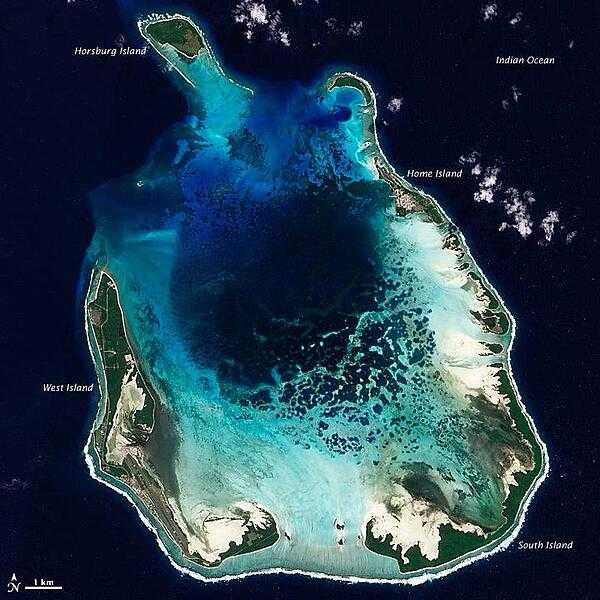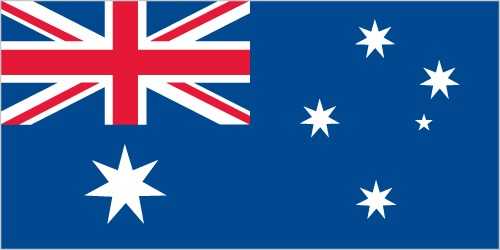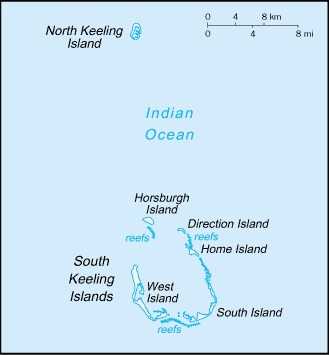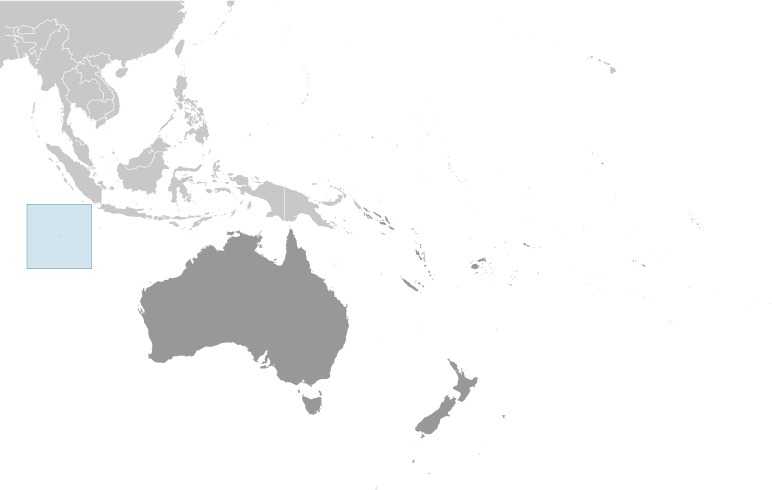Introduction
Background
British Captain William KEELING discovered the Cocos (Keeling) Islands in 1609, and they were named for their coconut trees in 1622. Some maps began referring to them as the Keeling Islands in 1703. In 1825, Scottish trader John CLUNIES-ROSS was trying to get to Christmas Island but was blown off-course and landed on Cocos (Keeling) Islands. The next year, a British trader hired CLUNIES-ROSS's brother to bring slaves and a harem of Malay women to create the first permanent settlement on the island. By the 1830s, the Clunies-Ross family had firmly established themselves as the leaders of the islands, and they ruled Cocos (Keeling) Islands in a feudal style until 1978.
The UK annexed the islands in 1857 and administered them from Ceylon after 1878 and from Singapore after 1886. The Cocos (Keeling) Islands hosted a cable relaying station and was attacked by the Germans in World War I. The Japanese similarly attacked the islands in World War II. The UK transferred the islands to Australia in 1955, when they were officially named the Cocos (Keeling) Islands, and in 1978, Australia bought all the land held by the Clunies-Ross family, ending their control of the islands. In a referendum in 1984, most islanders voted to integrate with Australia, and Western Australian laws have applied on the islands since 1992.
Visit the Definitions and Notes page to view a description of each topic.
Geography
Location
Southeastern Asia, group of islands in the Indian Ocean, southwest of Indonesia, about halfway between Australia and Sri Lanka
Geographic coordinates
12 30 S, 96 50 E
Map references
Southeast Asia
Area
total: 14 sq km
land: 14 sq km
water: 0 sq km
note: includes the two main islands of West Island and Home Island
comparison ranking: total 239
Area - comparative
about 24 times the size of The Mall in Washington, DC
Land boundaries
total: 0 km
Coastline
26 km
Maritime claims
territorial sea: 12 nm
exclusive fishing zone: 200 nm
Climate
tropical with high humidity, moderated by the southeast trade winds for about nine months of the year
Terrain
flat, low-lying coral atolls
Elevation
highest point: South Point on South Island 9 m
lowest point: Indian Ocean 0 m
Land use
agricultural land: 0% (2018 est.)
forest: 0% (2018 est.)
other: 100% (2018 est.)
Population distribution
only Home Island and West Island are populated
Natural hazards
cyclone season is October to April
Geography - note
note 1: there are 27 coral islands in the group; apart from North Keeling Island, which lies 30 km north of the main group, the islands form a horseshoe-shaped atoll surrounding a lagoon; North Keeling Island was declared a national park in 1995 and is administered by Parks Australia; the population on the two inhabited islands generally is split between the ethnic Europeans on West Island and the ethnic Malays on Home Island; the islands are thickly covered with coconut palms and other vegetation
note 2: site of a World War I naval battle in November 1914 between the Australian light cruiser HMAS Sydney and the German raider SMS Emden; after being heavily damaged in the engagement, the Emden was beached by her captain on North Keeling Island
People and Society
Population
total: 593
male: 301
female: 292 (2021 est.)
comparison rankings: female 229; male 229; total 236
Nationality
noun: Cocos Islander(s)
adjective: Cocos Islander
Ethnic groups
Europeans, Cocos Malays
Languages
Malay (Cocos dialect) 68.8%, English 22.3%, unspecified 8.9%; note - data represent language spoken at home (2016 est.)
major-language sample(s):
Buku Fakta Dunia, sumber yang diperlukan untuk maklumat asas. (Malay)
The World Factbook, the indispensable source for basic information.
Religions
Muslim (predominantly Sunni) 75%, Anglican 3.5%, Roman Catholic 2.2%, none 12.9%, unspecified 6.3% (2016 est.)
Age structure
0-14 years: 21.2%
15-64 years: 61.5%
65 years and over: 17.3% (2021)
Population distribution
only Home Island and West Island are populated
Environment
Environment - current issues
freshwater resources are limited to rainwater accumulations in natural underground reservoirs; illegal fishing a concern
Climate
tropical with high humidity, moderated by the southeast trade winds for about nine months of the year
Land use
agricultural land: 0% (2018 est.)
forest: 0% (2018 est.)
other: 100% (2018 est.)
Government
Country name
conventional long form: Territory of Cocos (Keeling) Islands
conventional short form: Cocos (Keeling) Islands
etymology: the name refers to the abundant coconut trees on the islands and to English Captain William KEELING, the first European to sight the islands in 1609
Government type
non-self-governing overseas territory of Australia
Dependency status
non-self governing territory of Australia; administered from Canberra by the Department of Infrastructure, Transport, Cities & Regional Development
Capital
name: West Island
geographic coordinates: 12 10 S, 96 50 E
time difference: UTC+6.5 (11.5 hours ahead of Washington, DC, during Standard Time)
Administrative divisions
none (territory of Australia)
Independence
none (territory of Australia)
National holiday
Australia Day (commemorates the arrival of the First Fleet of Australian settlers), 26 January (1788)
Constitution
history: 23 November 1955 (Cocos (Keeling) Islands Act 1955)
amendments: amended many times, last in 2020
Legal system
common law based on the Australian model
Citizenship
see Australia
Suffrage
18 years of age
Executive branch
chief of state: King CHARLES III (since 8 September 2022); represented by Governor-General of the Commonwealth of Australia General David HURLEY (since 1 July 2019)
head of government: Administrator Farzian ZAINAL (since 11 May 2023)
cabinet: NA
elections/appointments: the monarchy is hereditary; governor general appointed by the monarch on the recommendation of the Australian prime minister; administrator appointed by the governor-general for a 2-year term and represents the monarch and Australia
Legislative branch
description: unicameral Cocos (Keeling) Islands Shire Council (7 seats; members directly elected by simple majority vote to serve 4-year terms with 4 members renewed every 2 years)
elections: last held on 21 October 2023 (next to be held in October 2025)
election results: percent of vote by party - NA; seats by party - NA; composition - men 6, women 1, percent of women 16.7%
Judicial branch
highest court(s): under the terms of the Territorial Law Reform Act 1992, Western Australia provides court services as needed for the island including the Supreme Court and subordinate courts (District Court, Magistrate Court, Family Court, Children's Court, and Coroners' Court)
Diplomatic representation in the US
none (territory of Australia)
Diplomatic representation from the US
embassy: none (territory of Australia)
Flag description
the flag of Australia is used
National anthem
note: as a territory of Australia, "Advance Australia Fair" remains official as the national anthem, while "God Save the King" serves as the royal anthem (see Australia)
Economy
Agricultural products
vegetables, bananas, pawpaws, coconuts
Industries
copra products, tourism
Budget
revenues: NA
expenditures: NA
Fiscal year
1 July - 30 June
Exports - partners
United States 57%, Ireland 15% (2019)
Exports - commodities
integrated circuits, vaccines and cultures, furniture, carbon batteries, rubber gloves (2021)
Imports - partners
Australia 73%, United Arab Emirates 15%, Netherlands 5% (2019)
Imports - commodities
gold, x-ray equipment, cars, prefabricated buildings, packaged medicines (2019)
Exchange rates
Australian dollars (AUD) per US dollar -
Exchange rates:
1.311 (2017 est.)
1.3442 (2016 est.)
1.3442 (2015)
1.3291 (2014)
1.1094 (2013)
Communications
Telecommunication systems
general assessment: telephone service is part of the Australian network; an operational local mobile-cellular network available; wireless Internet connectivity available
domestic: local area code - 08
international: international code - 61 8; telephone, telex, and facsimile communications with Australia and elsewhere via satellite; satellite earth station - 1 (Intelsat)
Broadcast media
1 local radio station staffed by community volunteers; satellite broadcasts of several Australian radio and TV stations available (2017)
Internet users
total: 80 (2021 est.)
percent of population: 13.4% (2021 est.)
comparison ranking: total 233
Transportation
Ports and terminals
major seaport(s): Port Refuge
Military and Security
Military - note
defense is the responsibility of Australia



